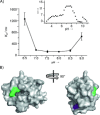Protein Surface Mimetics: Understanding How Ruthenium Tris(Bipyridines) Interact with Proteins
- PMID: 27860106
- PMCID: PMC5347857
- DOI: 10.1002/cbic.201600552
Protein Surface Mimetics: Understanding How Ruthenium Tris(Bipyridines) Interact with Proteins
Abstract
Protein surface mimetics achieve high-affinity binding by exploiting a scaffold to project binding groups over a large area of solvent-exposed protein surface to make multiple cooperative noncovalent interactions. Such recognition is a prerequisite for competitive/orthosteric inhibition of protein-protein interactions (PPIs). This paper describes biophysical and structural studies on ruthenium(II) tris(bipyridine) surface mimetics that recognize cytochrome (cyt) c and inhibit the cyt c/cyt c peroxidase (CCP) PPI. Binding is electrostatically driven, with enhanced affinity achieved through enthalpic contributions thought to arise from the ability of the surface mimetics to make a greater number of noncovalent interactions than CCP with surface-exposed basic residues on cyt c. High-field natural abundance 1 H,15 N HSQC NMR experiments are consistent with surface mimetics binding to cyt c in similar manner to CCP. This provides a framework for understanding recognition of proteins by supramolecular receptors and informing the design of ligands superior to the protein partners upon which they are inspired.
Keywords: molecular recognition; protein surface recognition; protein-protein interactions; receptors; supramolecular chemistry.
© 2017 Wiley-VCH Verlag GmbH & Co. KGaA, Weinheim.
Figures






Similar articles
-
Protein recognition of hetero-/homoleptic ruthenium(II) tris(bipyridine)s for α-chymotrypsin and cytochrome c.Bioorg Med Chem Lett. 2012 Mar 15;22(6):2354-8. doi: 10.1016/j.bmcl.2011.12.087. Epub 2011 Dec 23. Bioorg Med Chem Lett. 2012. PMID: 22385827
-
Protein destabilisation by ruthenium(II) tris-bipyridine based protein-surface mimetics.Org Biomol Chem. 2013 Apr 7;11(13):2206-12. doi: 10.1039/c3ob26251k. Org Biomol Chem. 2013. PMID: 23411505 Free PMC article.
-
Protein surface recognition using geometrically pure Ru(II) tris(bipyridine) derivatives.Chem Commun (Camb). 2011 Jan 7;47(1):559-61. doi: 10.1039/c0cc04754f. Epub 2010 Nov 23. Chem Commun (Camb). 2011. PMID: 21103575 Free PMC article.
-
The complex of cytochrome c and cytochrome c peroxidase: the end of the road?Biochim Biophys Acta. 2011 Nov;1807(11):1482-503. doi: 10.1016/j.bbabio.2011.07.010. Epub 2011 Jul 28. Biochim Biophys Acta. 2011. PMID: 21820401 Review.
-
Structure and Function of Transient Encounters of Redox Proteins.Acc Chem Res. 2015 Dec 15;48(12):3036-43. doi: 10.1021/acs.accounts.5b00343. Epub 2015 Nov 25. Acc Chem Res. 2015. PMID: 26606503 Review.
Cited by
-
Mutations in Spliceosomal Genes PPIL1 and PRP17 Cause Neurodegenerative Pontocerebellar Hypoplasia with Microcephaly.Neuron. 2021 Jan 20;109(2):241-256.e9. doi: 10.1016/j.neuron.2020.10.035. Epub 2020 Nov 20. Neuron. 2021. PMID: 33220177 Free PMC article.
-
Selectively inhibiting malignant melanoma migration and invasion in an engineered skin model using actin-targeting dinuclear RuII-complexes.RSC Med Chem. 2022 Nov 1;14(1):65-73. doi: 10.1039/d2md00280a. eCollection 2023 Jan 25. RSC Med Chem. 2022. PMID: 36755639 Free PMC article.
-
NMR Spectroscopy of supramolecular chemistry on protein surfaces.Beilstein J Org Chem. 2020 Oct 9;16:2505-2522. doi: 10.3762/bjoc.16.203. eCollection 2020. Beilstein J Org Chem. 2020. PMID: 33093929 Free PMC article. Review.
-
Generation of Dynamic Combinatorial Libraries Using Hydrazone-Functionalized Surface Mimetics.European J Org Chem. 2018 Apr 30;2018(16):1872-1879. doi: 10.1002/ejoc.201800022. Epub 2018 Apr 25. European J Org Chem. 2018. PMID: 29780280 Free PMC article.
-
Proteomimetic surface fragments distinguish targets by function.Chem Sci. 2020 Sep 10;11(38):10390-10398. doi: 10.1039/d0sc03525d. Chem Sci. 2020. PMID: 34094300 Free PMC article.
References
-
- Arkin M. R., Wells J. A., Nat. Rev. Drug Discovery 2004, 3, 301–317. - PubMed
-
- Wilson A. J., Chem. Soc. Rev. 2009, 38, 3289–3300. - PubMed
-
- Edfeldt F. N. B., Folmer R. H. A., Breeze A. L., Drug Discovery Today 2011, 16, 284–287. - PubMed
-
- Waring M. J., Arrowsmith J., Leach A. R., Leeson P. D., Mandrell S., Owen R. M., Pairaudeau G., Pennie W. D., Pickett S. D., Wang J., Wallace O., Weir A., Nat. Rev. Drug Discovery 2015, 14, 475–486. - PubMed
-
- Azzarito V., Long K., Murphy N. S., Wilson A. J., Nat. Chem. 2013, 5, 161–173. - PubMed
MeSH terms
Substances
Grants and funding
LinkOut - more resources
Full Text Sources
Other Literature Sources

